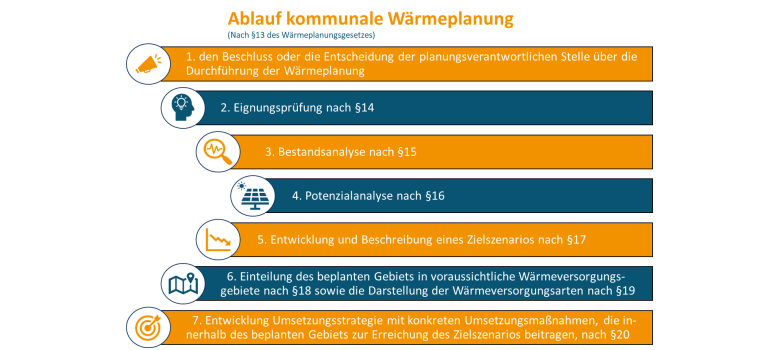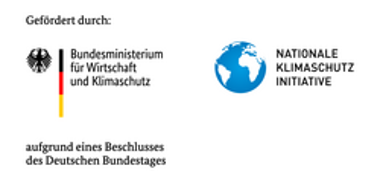Municipal heat planning
At the beginning of October 2023, the pilgrimage town of Kevelaer embarked on the path to a greenhouse gas-neutral heat supply with the funding project "KSI: Municipal heat planning for the pilgrimage town of Kevelaer". The municipal heat planning will be completed in December 2024.
The aim of the funding project is the creation of a municipal heating plan by expert external service providers in order to create a coordinated basis for a greenhouse gas-neutral municipal heating supply by 2045. Until then, the municipal heating plan will be regularly updated in order to keep both the planning and technical aspects up to date.
Contents of municipal heat planning
According to the Heat Planning Act, municipal heat planning comprises seven sub-steps. Following the decision by the planning authority, a rough suitability test is first carried out in order to exclude sub-areas for a specific type of heat supply. The current heating infrastructure is then recorded in the inventory analysis. In the potential analysis, all renewable potential for heat generation is analyzed. Based on the results, a target scenario for a greenhouse gas-neutral heat supply is then outlined, which, among other things, makes a building-specific division into suitable areas for grid-based heat supply, supply with green gases and individual supply. The implementation strategy describes various measures for the pilgrimage town of Kevelaer with which the outlined target scenario is to be achieved.
A participation concept and a communication strategy are also being developed to take all stakeholders into account. A controlling concept and a continuation strategy are also being developed to ensure that the targets set out in the municipal heating plan are met.

Aim of municipal heat planning
The aim of the pilgrimage town of Kevelaer is to use municipal heating planning to support citizens in choosing their future heating supply. The debate surrounding the Building Energy Act ("Heating Act") has caused uncertainty and anxiety for many. Municipal heating planning is intended to help shed light on the situation, weigh up different heating supply options and provide guidance and a basis for planning for the coming years.
In addition to relevant stakeholders such as municipal utilities and regional energy suppliers, the public is also involved at an early stage and regularly informed about the progress of municipal heating planning, e.g. about the results of the inventory and potential analysis.
Furthermore, the feasibility of a district heating network in the municipal area is provisionally assessed in the municipal heating planning. The construction of a district heating network would offer citizens the prospect of a greenhouse gas-neutral heat supply and compliance with the requirements of the Building Energy Act.
Current status of municipal heat planning
The interim results of the status analysis were presented at the public event on 06.03.24. The participants suggested ideas and potentials that were included in the potential analysis. The inventory analysis and potential analysis were finalized and presented at a second public event on 28.08.24. A detailed interim report will be published on the website shortly.
Legal background
Municipal heat planning is required by law under the Heat Planning and Decarbonization of Heating Networks Act (WPG), which came into force on 1 January 2024. Municipalities such as the pilgrimage town of Kevelaer with fewer than 100,000 inhabitants* must draw up a heating plan by 30.06.2028 in accordance with Section 4 of the WPG.
Answers to frequently asked questions about municipal heat planning can be found under: FAQ Heat planning.
The Heat Planning Act is also linked to the amended Act on the Conservation of Energy and the Use of Renewable Energies for Heating and Cooling in Buildings (GEG). From January 1, 2024, every newly installed heating system in new buildings within new development areas must be powered by 65% renewable energy. For areas outside new development areas and existing buildings, this rule only applies once the results of the municipal heat planning have been decided. It is important to note that this only applies to newly installed heating systems. Functioning heating systems may continue to run for the time being and defective heating systems may be repaired.
You can read the most frequently asked questions about the GEG here: FAQ GEG. You can find the entire GEG here.
Notes on choosing a type of heat supply
Until the results of the municipal heat planning are published, the citizens of the pilgrimage town of Kevelaer are legally entitled to install a fossil fuel heating system. However, this is not necessarily the best financial decision for two reasons.
Firstly, all fossil fuel heating systems installed from 01.01.2024 onwards must gradually comply with certain blending obligations for renewable fuels (e.g. green gases or green heating oil) in their heating systems by 2045. From 2029, this proportion will be 15 percent, from 2035 30 percent and from 2040 60 percent. However, the availability and costs of these renewable fuels are currently very uncertain.
On the other hand, theCO2 price for fossil fuels will continue to rise. As of 01.01.2024, theCO2 price has risen to €45 per tonne, which means an additional charge of 0.816 cents for a kilowatt hour (kWh) of natural gas. Next year, theCO2 price is set to rise to €55 per tonne. Theprice of CO2 will continue to rise significantly until 2045, meaning that theprice of CO2 could exceed the price of natural gas alone in the future, according to forecasts. The running costs should therefore be compared carefully.
Get free advice from our energy experts in an initial consultation. The costs of measures for renewable heat supply can often be greatly reduced through subsidies. You can find the consultation offer here.
When repairing or installing a gas heating system, tradesmen are obliged to provide advice.
Further information on the funding project
The creation of the municipal heating plan is funded by the Federal Ministry for Economic Affairs and Climate Protection under the funding code 67K24377 on the basis of a resolution of the German Bundestag. The funding period runs from 01.10.2023 to 30.09.2024. The pilgrimage town of Kevelaer is being supported by HORIZONTE-Group GmbH from Gelsenkirchen in the implementation of the funding project.

With the National Climate Initiative, the Federal Environment Ministry has been initiating and funding numerous projects that contribute to reducing greenhouse gas emissions since 2008. Its programs and projects cover a broad spectrum of climate protection activities: From the development of long-term strategies to concrete assistance and investment support measures. This diversity is a guarantee for good ideas. The National Climate Initiative helps to anchor climate protection on the ground. It benefits consumers as well as companies, local authorities and educational institutions.

